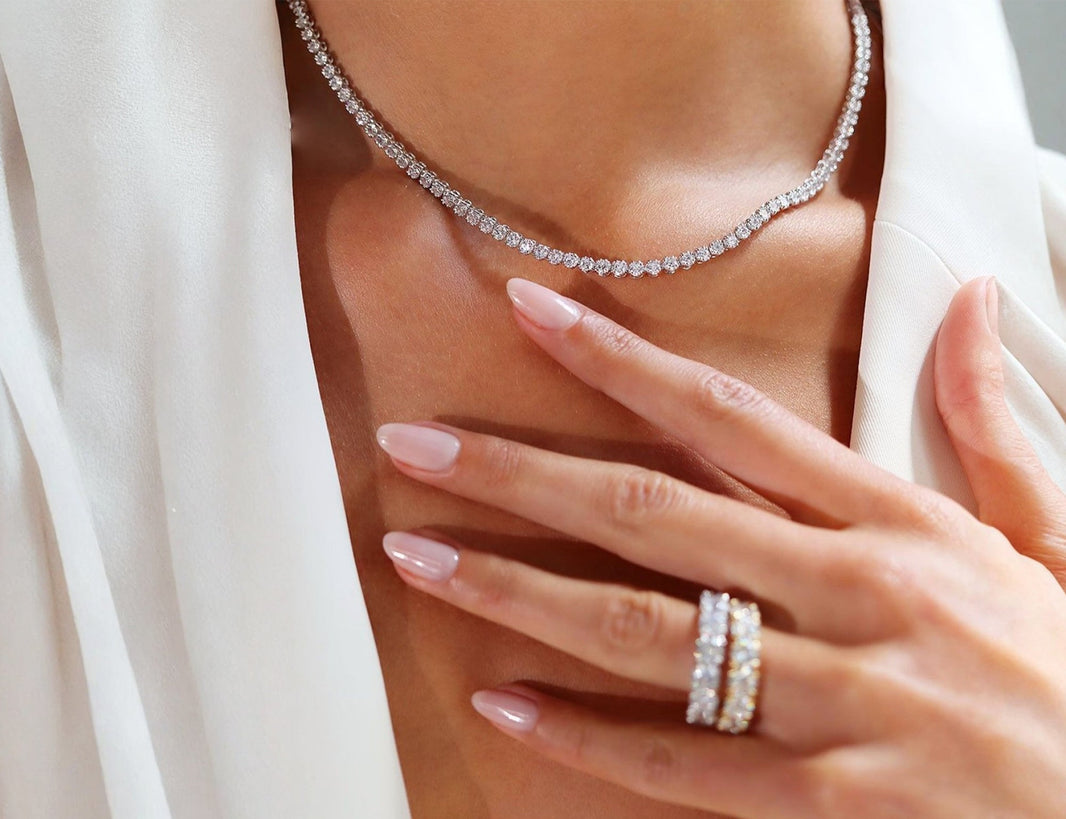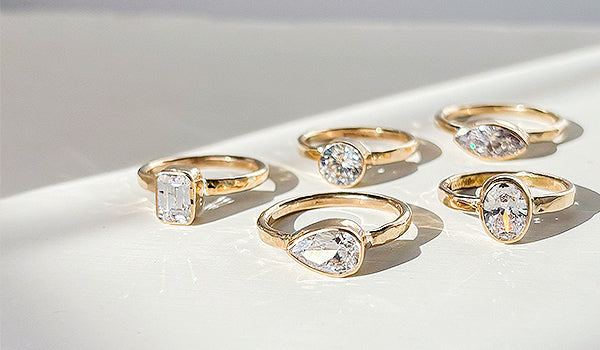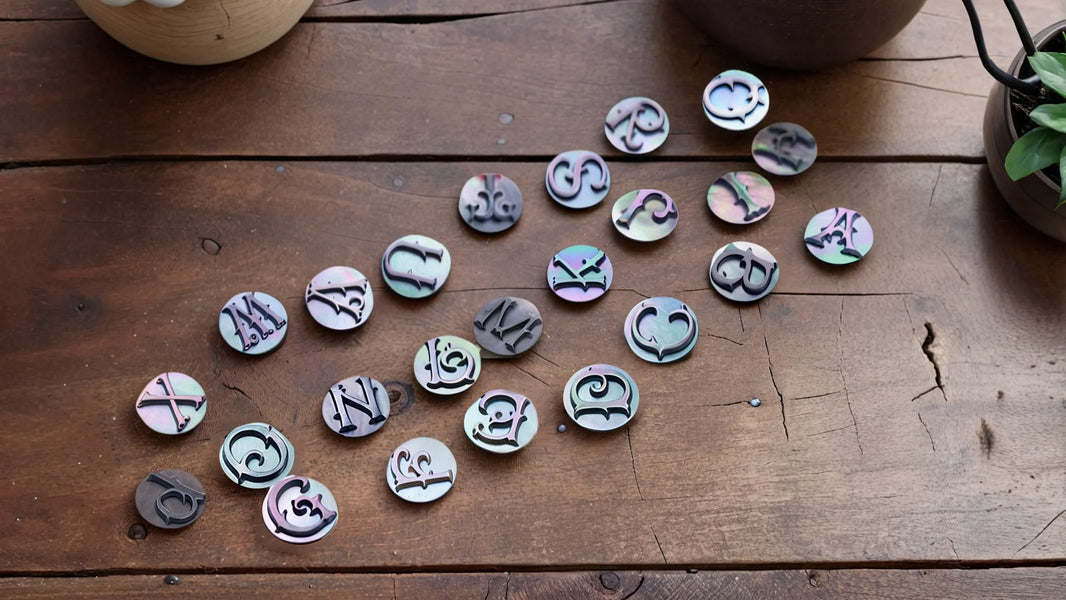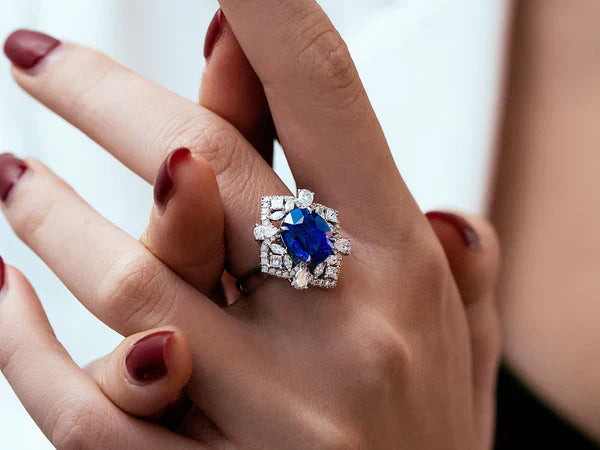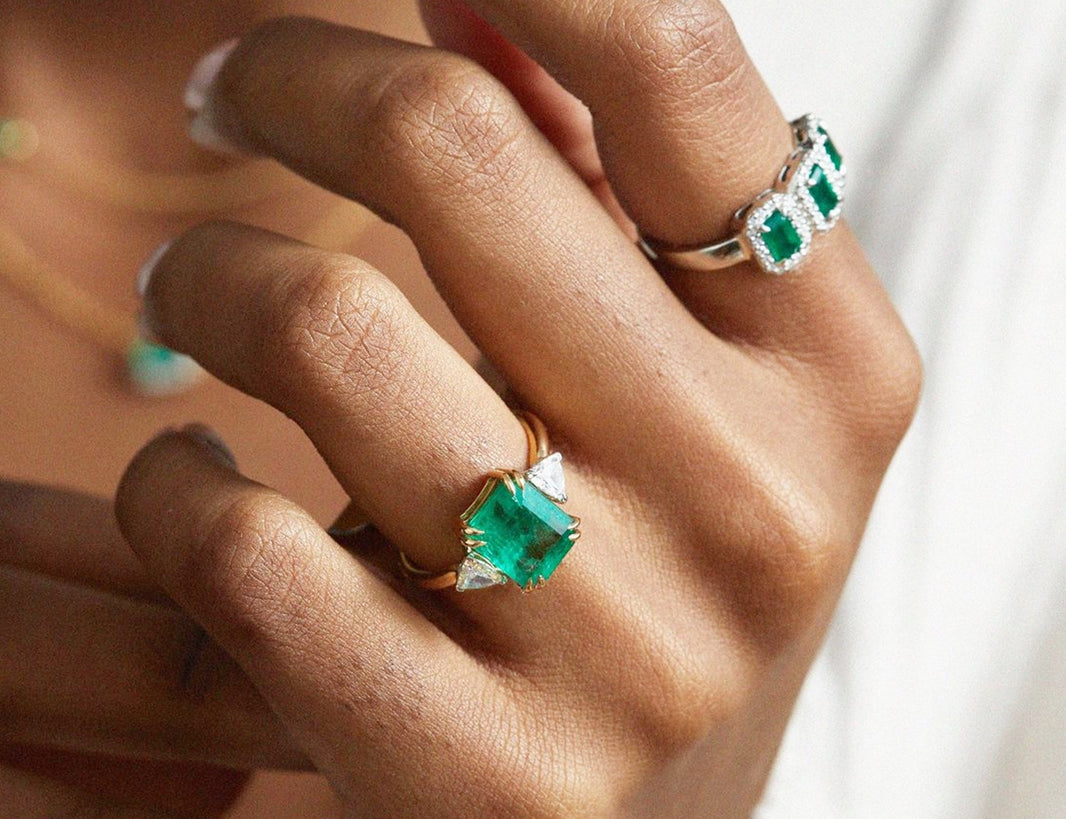Looking beyond diamonds for your engagement ring? You're not alone! Colorful gemstones are catching on fast, bringing personal meaning and eye-catching sparkle to ring fingers everywhere. While some worry about durability, plenty of gemstones can handle daily life just fine. We'll walk you through the best non-diamond engagement rings, which stones actually last, and simple ways to keep your unique ring looking gorgeous for years to come.

Why Non-Diamond Gemstones Are Becoming Popular
Non-diamond gemstones are quickly becoming the new favorite choice for engagement rings, thanks to their beauty and variety. Despite concerns over their hardness compared to diamonds, the majority of them areR baseless.
There's a common misconception that softer stones are too fragile, but this isn't always true. Take jade, for example. Though it has a Mohs hardness of 6.5, it's actually quite resistant to cracking and can even be more durable than harder gems such as Topaz, which has an 8. That's due to the fact that jade has a special crystal structure that makes it less likely to chip or crack, even if you bump or drop it.
When choosing a non-diamond stone for everyday wear, it is best to consider its hardness rating. The stones with a hardness of 7.5 and above are less prone to scratches and wear. Sapphire, ruby, and emerald are some of those that fall into this category and are as beautiful as they are long-lasting, making them excellent choices for engagement rings.

How to Evaluate Non-Diamond Gemstone Quality
When choosing a non-diamond gemstone for an engagement ring, it's crucial to evaluate its quality. This ensures that your chosen gem is not only beautiful but also durable and valuable. Here’s how you can assess the quality of non-diamond gemstones:
1. Choose Gems with Rich, Even Color Throughout
Color is usually what catches our eye for gemstones. In the case of sapphires, the most expensive display a rich, plush blue—such as Kate Middleton's legendary engagement ring. In rubies, find one with a deep "pigeon blood" red that isn't too light or too dark. Emeralds must have a rich green that's not too yellowish or bluish. When viewing any gemstone, look at it in various lighting—natural daylight displays the real color, whereas indoor lighting will pick up other tones.

2. Look for Stones with Minimal Visible Inclusions
Every gemstone tells its own story through its inclusions. While a flawless sapphire is rare and valuable, a completely clear emerald is practically nonexistent. Emeralds typically have garden-like inclusions (called "jardin") that gemologists actually expect to see as proof they're natural. For everyday wear in an engagement ring, choose stones where you can't see inclusions without magnification. A good rule: if you can see flaws from arm's length, they might affect the stone's durability.
3. Ensure Your Gemstone Has a Precise Cut That Enhances Sparkle
The right cut makes a gemstone come alive. Tanzanite, well cut, shows its phenomenal color-shifting from blue to purple. Oval cuts are used to enhance a ruby's color and apparent size. For emeralds, the rectangular "emerald cut" with step-cut facets was specifically created to show this gem's rich color while protecting its more fragile nature. Look at how light travels through the stone—it should sparkle evenly with no dark areas or windowing (ability to see through the stone).
4. Balance Size with Quality for the Best Value
Different gemstones have different densities, so a 1-carat sapphire looks smaller than a 1-carat emerald. A 1-carat round sapphire is about 6mm across, while a 1-carat round emerald is closer to 6.5mm. Don't just go for the largest stone—a well-cut 1.5-carat morganite will look more impressive than a 2-carat stone that's not well-cut. Most engagement ring gemstones look substantial at 1-2 carats.
5. Ask About All Treatments Applied to the Stone
Ninety-nine percent of rubies and sapphires on the market are heat-treated for color enhancement—this is standard industry practice and widely accepted. Be wary of fracture-filled stones (especially emeralds) with cracks filled by oils or resins that deteriorate with time. Ask directly: "Has this stone been treated in any way beyond standard industry practice?" Untreated stones command a premium—an untreated Burmese ruby could be 10-15% more expensive than an equally quality treated one.
6. Request Proper Certification from Reputable Labs
An ethical report from GIA or AGL tells you exactly what you're buying. For example, a GIA report will reveal if it's natural sapphire or synthetic and if any treatment was done. For expensive gems (usually $1,000+), this document matters—particularly for emeralds, rubies, and sapphires in which origin factors greatly into worth. Colombian emeralds and Burmese rubies command premium prices compared to other regions.
Top 7 Non-Diamond Stones for Engagement Rings
Choosing a non-diamond gemstone for an engagement ring can make a bold, yet powerful statement. Here are seven popular options that offer stunning beauty, durability, and distinctive charm:
1. Sapphire
Sapphires are renowned for their deep blue hues, though they also come in a variety of colors, including pink, yellow, and green. They have a 9 on the Mohs hardness scale, making them very durable and wearable every day. Their royal allure and timeless elegance have made sapphires a favorite choice for engagement rings.
2. Ruby
Rubies symbolize love and passion with their intense, red color. The deep color of a ruby coupled with its high hardness (also a 9 on the Mohs scale) renders it both beautiful and durable. Rubies are typically the most valuable of all the colored gemstones and have been greatly valued throughout history.

3. Emerald
Emeralds tempt with their rich green color, which represents renewal and growth. A bit softer, with a Mohs hardness of 7.5 to 8, careful settings and regular maintenance can work to preserve their beauty. Emeralds are a classic choice for anyone seeking a stone with intense color and historical significance.
4. Aquamarine
Aquamarines give a calming and serene light blue color that is appealing to the majority. At 7.5 to 8 on the Mohs hardness scale, they are relatively durable and give a cooling feel to engagement rings. Aquamarine is often regarded as a peaceful and lucid gemstone, and thus a beautiful choice for a lasting symbol of commitment.
5. Morganite
Morganite is prized for its pale pink colors, expressing a dainty and elegant elegance. Morganite's Mohs hardness of between 7.5 and 8 presents sufficient durability for constant wear. Morganite's soft blush color will complement most metal colors, notably rose gold, enhancing its own beauty.
6. Amethyst
Amethysts are of an imperial purple hue and have a reputation for being fairly inexpensive and charming. Having a Mohs hardness of around 7, they must be treated with some care but remain a favorite of those who wish for a shining but clear-cut look. Amethysts are reputed to create calmness and balance, adding depth to their beauty.
7. Topaz
Topaz comes in a range of colors, from golden yellows to cool blues, offering versatility and beauty. Blue topaz, with its clear and bright shades, is particularly popular. With a Mohs hardness of 8, topaz is fairly resistant to scratches, making it a practical and eye-catching option for engagement rings.
Gemstones to Avoid for Engagement Rings
While the majority of non-diamond engagement ring stones provide beautiful and durable engagement ring possibilities, there are a few that are less desirable due to their inherent characteristics. Some gemstones you might want to think twice about when selecting an engagement ring due to the disadvantages they can pose in maintenance and durability are as follows:
- Opal: Opals are dazzling with their play-of-color iridescence, but they are extremely delicate, with a Mohs hardness of only 5.5 to 6. This makes them prone to scratching, chipping, and cracking, especially if worn daily. Their softness and the fact that they contain water make opals likely to crack in dry or extreme conditions.
- Pearl: Although pearls exude classic elegance and sophistication, they are not ideal for engagement rings since they are soft. Pearls have a Mohs hardness of just 2.5 to 4.5, so they can be scratched or damaged easily. They also require special handling to avoid damage from chemicals and physical impact.
- Tanzanite: Tanzanite is valued for its deep blue-violet color but is very soft, with a Mohs hardness of 6 to 7, and is prone to chipping. It has cleavage planes that cause it to be more prone to breaking, and therefore special care would be needed to maintain its beauty over time, which might not be practical for everyday wear.
- Moonstone: Moonstone is valued for its ethereal glow and adularescence but is extremely fragile. It is 6 to 6.5 on the Mohs scale and will scratch or shatter easily. Its relative softness also makes it unsuitable for the rigors of daily wear, so it is not the ideal option for engagement rings to be worn every day.
- Amber: Amber is valued for its warm, yellowish color and organic origin, but it's one of the softest materials used for jewelry, with a Mohs hardness of approximately 2 to 2.5. It's highly susceptible to scratching and abrasion and can even dissolve in certain solvents, such as alcohol.
- Fluorite: Fluorite is available in many colors and also possesses a nice luster, but it is somewhat soft at approximately 4 on the hardness scale and is very easy to scratch and chip. Hence, fluorite is not generally advised for everyday wear engagement rings.
Choosing a gemstone that balances beauty with practicality is crucial for an engagement ring. While these stones possess unique characteristics that may appeal to many, their physical properties make them better suited for occasional wear rather than the daily demands of an engagement ring.
How to Maintain Your Gemstone Rings
Keep your non-diamond gemstone rings sparkling with these simple care techniques that protect both the stones and settings for years to come.
Cleaning Protocols by Stone Type
Different gemstones possess specific cleaning techniques to maintain their beauty:
- Hard stones (sapphires, rubies, lab-created diamonds): Soak in warm water and mild dish soap for 20 minutes, followed by brushing with a soft toothbrush, with special care where skin oils congregate.
- Medium stones (amethyst, aquamarine): Wipe with a microfiber cloth that has been dampened with a weak mild soap, avoiding exposure to too much water. A quick rinse and immediate drying with a lint-free cloth.
- Soft stones (emeralds, opals): Never soak or use an ultrasonic cleaner. Instead, gently wipe with a slightly damp microfiber cloth and dry immediately to prevent water damage to these softer gems.
- Porous stones (pearls, amber): These will absorb liquids easily, so no soaking whatsoever. Clean only with a soft cloth that is just damp, and never with any chemicals or commercial jewelry cleaners.

Professional Care Timeline
Regular professional maintenance ensures your gemstone rings remain beautiful and structurally sound for generations.
| Timeframe | Service Needed | Why It's Important |
|---|---|---|
| Every 6 months | Prong and setting check | Prevents stone loss from loose settings |
| Annually | Professional deep cleaning | Removes buildup in hard-to-reach areas |
| Every 1-2 years | Replating (white gold) | Restores original finish and prevents allergic reactions |
| Before special events | Complete inspection | Ensures your rings look their best for important occasions |
| Every 3-5 years | Polishing and refinishing | Removes scratches and restores metal luster |
Maintaining this professional care schedule prevents minor issues from becoming major problems and helps preserve both the beauty and value of your gemstone rings over time.
Store Your Gemstone Rings Properly
Proper storage is essential for protecting your non-diamond gemstone rings when not being worn. Here's how you can store them properly:
- Store each ring in its own soft fabric pouch to prevent scratches from other jewelry pieces and protect softer gemstones from damage by harder stones like lab-created diamonds.
- Keep your ring collection away from windows and heating vents where temperature fluctuations and direct sunlight can damage certain gemstones and cause metal settings to expand and contract.
- Place rings in a designated dish or holder when washing hands or applying beauty products rather than balancing them on slippery sink edges where they could fall down drains.
- Remove rings before applying lotions, perfumes, or hairspray, as chemical residues can build up beneath stones and dull their appearance over time by trapping dirt and oils.
Non-Diamond Gemstone Rings FAQs
1. Will non-diamonds look cheap?
No. High-quality sapphires, rubies, and emeralds look stunning and valuable. The beauty comes from the stone's color, clarity, cut, and setting quality—not whether it's a diamond.
2. How to ensure ethical sourcing?
To ensure your non-diamond gemstone is ethically sourced, buy from jewelers who provide detailed provenance information or certifications like those from the Responsible Jewellery Council (RJC). Ask directly about stone origins and request proof they're conflict-free.
3. Can I resize gemstone rings later?
Yes, most can be resized. Softer non-diamond stones need extra care during the process. Always use a jeweler experienced with your specific gemstone type.
4. Are gemstones cheaper than diamonds?
Generally yes. Most colored gemstones are less costly than same-size diamonds. But very fine sapphires and rubies are sometimes more costly than diamonds due to rarity.
5. Can I pair colored gemstones with my existing jewelry?
Absolutely. Match colors within the same family or deliberately contrast with complementary colors. Mixed metals also work beautifully, giving you styling versatility.
6. Do colored gemstones have symbolic meanings?
Yes. Sapphires represent wisdom and loyalty, emeralds represent rebirth, and rubies represent passion and protection, among many other traditional meanings.
7. Will lab-grown gemstones lose color over time?
No. Lab-created gemstones will hold their color in the same manner natural stones do since they're chemically identical. Cleaning them periodically and staying away from harsh chemicals will maintain their beauty




